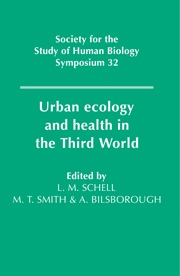Book contents
- Frontmatter
- Contents
- List of contributors
- Acknowledgements
- 1 Human biological approaches to the study of Third World urbanism
- 2 Social and cultural influences in the risk of cardiovascular disease in urban Brazil
- 3 The urban disadvantage in the developing world and the physical and mental growth of children
- 4 Differences in endocrine status associated with urban-rural patterns of growth and maturation in Bundi (Gende-speaking) adolescents of Papua New Guinea
- 5 Nutritionally vulnerable households in the urban slum economy: a case study from Khulna, Bangladesh
- 6 Urban-rural differences in growth and diarrhoeal morbidity of Filipino infants
- 7 Child health and growth in urban South Africa
- 8 From countryside to town in Morocco: ecology, culture and public health
- 9 Urban-rural population research: a town like Alice
- 10 Selection for rural-to-urban migrants in Guatemala
- 11 Health and nutrition in Mixtec Indians: factors influencing the decision to migrate to urban centres
- 12 Urban health and ecology in Bunia, N.E. Zaire, with special reference to the physical development of children
- 13 Food for thought: meeting a basic need for low-income urban residents
- 14 Immunological parameters in northeast Arnhem Land Aborigines: consequences of changing settlement patterns and lifestyles
- 15 Amerindians and the price of modernisation
- 16 Sex ratio determinants in Indian populations: studies at national, state and district levels
- 17 Polarisation and depolarisation in Africa
- 18 Urbanisation in the Third World: health policy implications
- Index
11 - Health and nutrition in Mixtec Indians: factors influencing the decision to migrate to urban centres
Published online by Cambridge University Press: 26 December 2009
- Frontmatter
- Contents
- List of contributors
- Acknowledgements
- 1 Human biological approaches to the study of Third World urbanism
- 2 Social and cultural influences in the risk of cardiovascular disease in urban Brazil
- 3 The urban disadvantage in the developing world and the physical and mental growth of children
- 4 Differences in endocrine status associated with urban-rural patterns of growth and maturation in Bundi (Gende-speaking) adolescents of Papua New Guinea
- 5 Nutritionally vulnerable households in the urban slum economy: a case study from Khulna, Bangladesh
- 6 Urban-rural differences in growth and diarrhoeal morbidity of Filipino infants
- 7 Child health and growth in urban South Africa
- 8 From countryside to town in Morocco: ecology, culture and public health
- 9 Urban-rural population research: a town like Alice
- 10 Selection for rural-to-urban migrants in Guatemala
- 11 Health and nutrition in Mixtec Indians: factors influencing the decision to migrate to urban centres
- 12 Urban health and ecology in Bunia, N.E. Zaire, with special reference to the physical development of children
- 13 Food for thought: meeting a basic need for low-income urban residents
- 14 Immunological parameters in northeast Arnhem Land Aborigines: consequences of changing settlement patterns and lifestyles
- 15 Amerindians and the price of modernisation
- 16 Sex ratio determinants in Indian populations: studies at national, state and district levels
- 17 Polarisation and depolarisation in Africa
- 18 Urbanisation in the Third World: health policy implications
- Index
Summary
In recent decades, Mexico has experienced rapid and drastic demographic, economic and sociocultural changes, which have modified both the conditions of life and the population structure. The Mexican government has made great efforts to improve education, accommodation, hygiene and food quality, and to control tropical diseases (UNDP, 1990). In 1960 the under five mortality rate was 140 per thousand; in 1988 it was 68 per thousand. In 1981 the percentage of one-year-old children with at least one disease was 50; in 1988 it was 75. The adult illiteracy rate fell from 26% in 1970 to 10% in 1985. This process of national development has been slowed by the other changes that are occurring. One such, with far-reaching effects, is the considerable migration to urban from rural areas: the urban population increased from 51% in 1960 to 71% in 1988. This has led to rapid growth of suburban areas in Mexico City, Vera Cruz, Guadalajara and other large towns (indeed, Guadalajara has a population density of 10286 per square km), where year by year the living conditions have deteriorated, become less acceptable, and less controllable. As a generalisation it seems that the worse the antecedent rural environment of the migrants, the worse the condition of their suburban settlements.
A second major problem is the worsening condition of some rural populations, among them the traditional Indian tribes or communities. Their situation has deteriorated through cultural, linguistic, historical and political isolation much more than through deterioration of their geographical environment.
- Type
- Chapter
- Information
- Urban Ecology and Health in the Third World , pp. 163 - 171Publisher: Cambridge University PressPrint publication year: 1993



